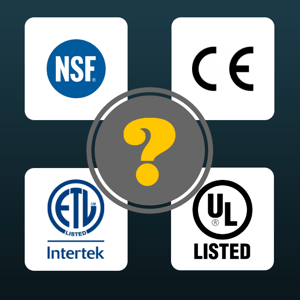
When you’re buying a high-performance blender or other restaurant equipment, you care about how much it costs. You care about how easy it is to operate and how long the warranty lasts. You probably don’t care about all the mysterious agency certifications it has: NSF, ETL, UL… Should you?
Yes. For one, health inspectors look at these marks. They want proof that your kitchen equipment is certified to be sanitary and safe. Also, certified foodservice equipment is better for your bottom line: more durable, safer for employees to use, and easier to clean so your risk of foodborne illness is decreased. But restaurant equipment certifications can be cryptic and confusing. There’s a lot of overlap between them, yet standards recognized in the United States may not count elsewhere in the world.
Here’s a quick rundown of what you need to know.
What does “NSF certified” mean?
NSF originally stood for the National Sanitation Foundation, but as this nonprofit expanded its mission, it ditched the name and simply kept the initials. NSF International establishes public health standards and certification programs that help protect the world’s food, water, consumer products and environment. What does this lofty goal have to do with commercial blenders? NSF’s independent experts test foodservice equipment to make sure it meets high safety and sanitation standards. So when you see “NSF” on your HBF1100S EXPEDITOR blender, it means, among other things, that the product won’t leach harmful chemicals into food and that it’s easily cleaned.
What does “UL Listed” mean?
The little “UL Listed” label is probably the most recognizable product certification. It appears on most electrical appliances in your house: lamps, TVs, toasters. UL stands for Underwriters Laboratories, a safety science company that tests thousands of consumer and commercial products each year for electrical safety and design quality. Sometimes the “UL Listed” symbol is flanked by a C and a US, which means it meets both Canadian and U.S. safety standards. UL has its own sanitation certification, indicated by the UL EPH mark; if the mark also says “Classified,” the product complies with ANSI/NSF regulations.
What does the CE mark mean?
The CE mark is used to indicate that a piece of equipment conforms to safety, health, and environmental protection standards set by the European Union. (It’s an abbreviation of Conformité Européenne, meaning European Conformity.) Meeting CE standards is mandatory; without the designation, certain products can’t be sold across all 30 countries in the European Economic Area.
What does “ETL Listed” mean?
The ETL mark is used by Intertek, one of the world's largest testing, inspection and certification companies. “ETL Listed” means that a product meets North American safety standards.
Other foodservice equipment certifications you may see
Here’s the upshot: whether a particular product is marked NSF, UL, CE or ETL, all these certifications indicate that the product has met certain, rigorous safety standards. Ready for another serving of alphabet soup? Here are a few more marks you may see on kitchen equipment.
- NOM (Norma Oficial Mexicana) requirements are mandatory for electrical products exported into Mexico.
- CSA stands for the Canadian Standards Association, which tests equipment to the same standards as NSF and UL.
- CCC (China Compulsory Certification) is required for certain foreign products imported into China, including food processors and rice cookers. To receive the CCC mark, a product must be tested by laboratories in China, and a Chinese auditor must inspect the manufacturer’s facilities.
- Inmetro is Brazil’s National Institute of Metrology, Quality and Technology, which certifies the safety of certain appliances and other products.
- RoHS (Restriction of the Use of Certain Hazardous Substances) is the European Union directive that restricts the use of hazardous materials in electrical and electronic products. These materials include lead, mercury, cadmium, hexavalent chromium, polybrominated biphenyls (PBB) and others. Hamilton Beach Commercial’s products are RoHS-compliant.
- Last but not least, the WEEE symbol is the proper name for that little trash can with the X over it. This mark means the product complies with the Waste Electrical and Electronic Equipment Directive, and indicates that it should be recycled as e-waste, not thrown away.
Don’t ignore the WEEE symbol! Did you know the average American generated 48.6 lbs. of e-waste in 2014? Much of that waste is both hazardous and potentially valuable, as electronics consume increasingly scarce minerals. When your old Hamilton Beach Commercial equipment reaches the end of its life (which should take a long, long time), send it back to us and we’ll recycle it for you.
At Hamilton Beach Commercial, we’re passionate about making high-quality, durable restaurant equipment. Have questions about a specific product? On our website, you can click the “Specifications” tab on any product to see its certifications. Or, contact us anytime.


